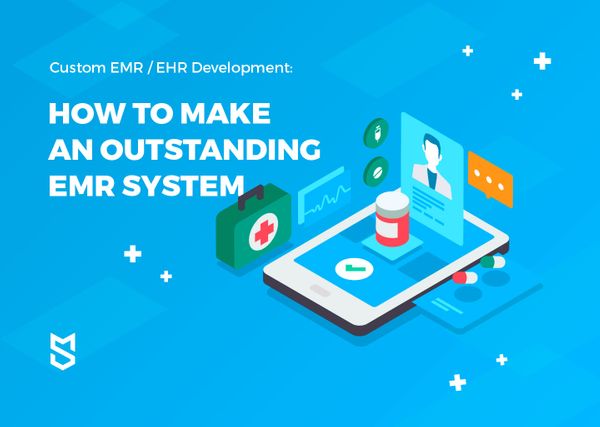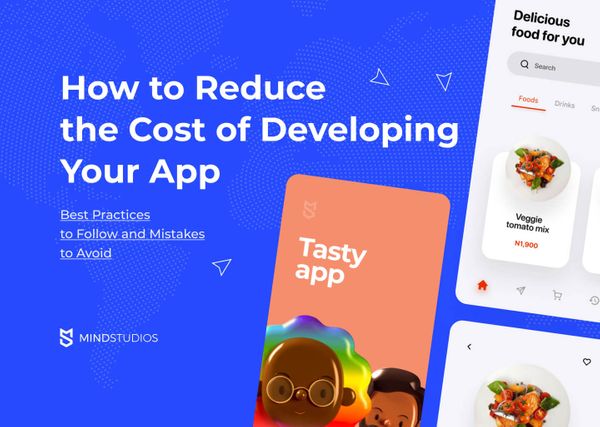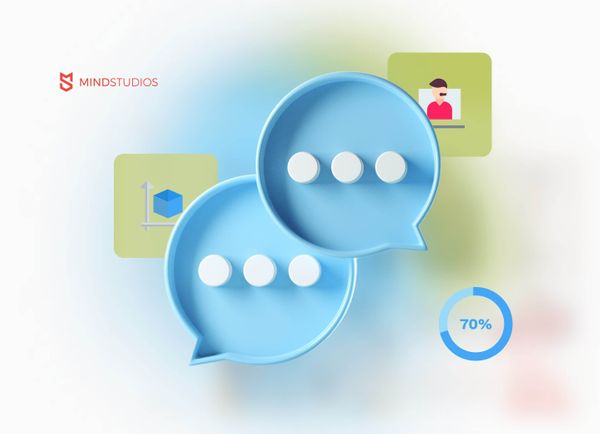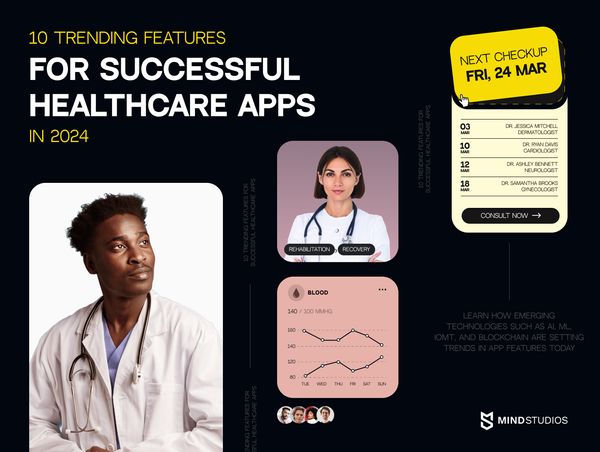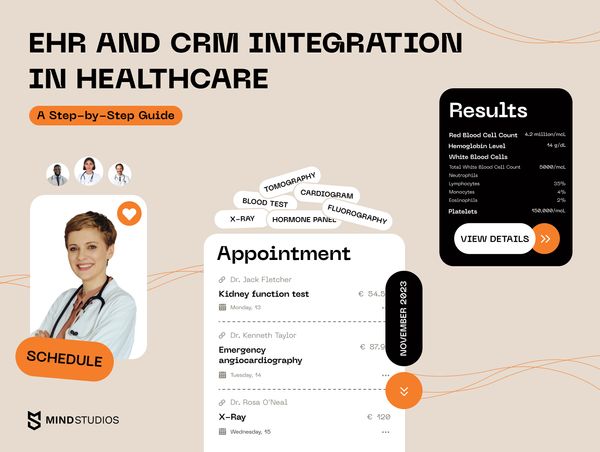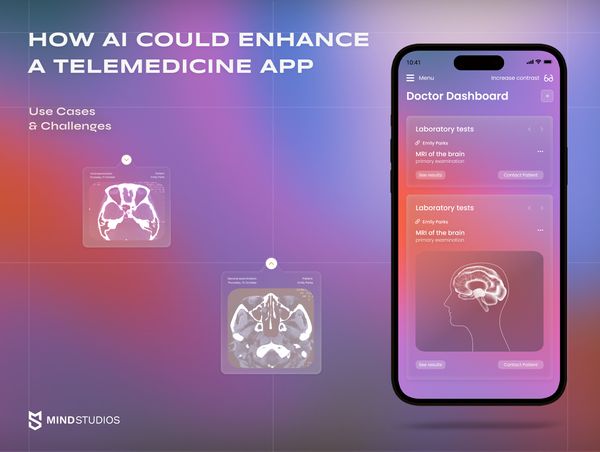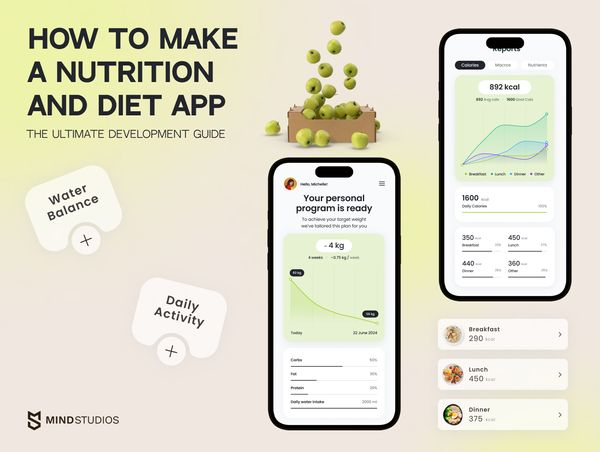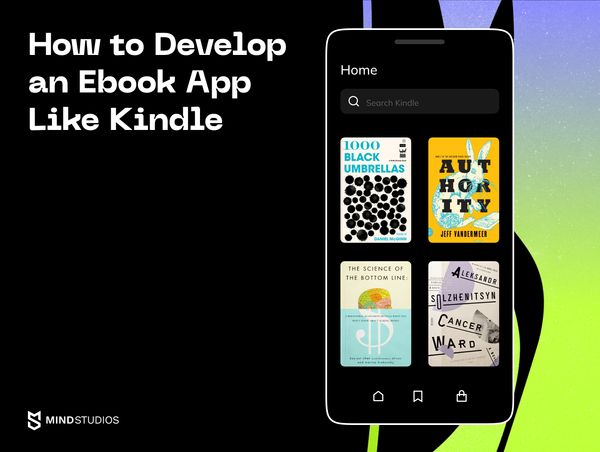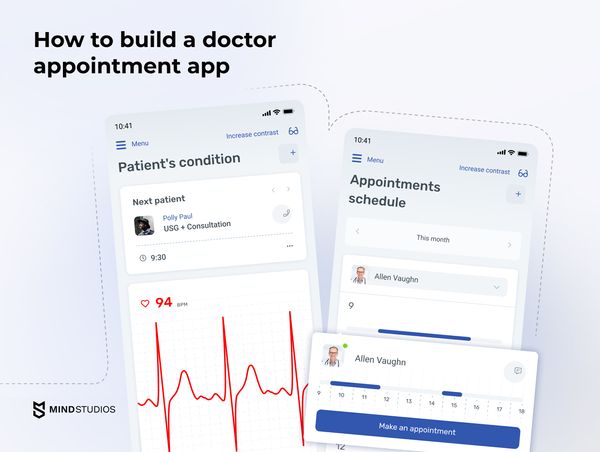
Empty slots. No-show patients. Annoyed staff overwhelmed with administrative tasks. You feel there must be something that can help your clinic sidestep all these issues. The coronavirus pandemic caused rapid demand for mHealth apps, and it continues to grow now. So developing a doctor appointment app seems like a good idea.
But what features should your app provide to satisfy both doctors and patients? What technologies and tools to use to make your app work smoothly? How to set up the doctor scheduling app development process to get a final product that will meet your requirements?
Chances are, this isn’t a complete list of the questions you’re concerned with, so we’ve prepared an extensive post with insights on this topic.
We’ll lead you through seven fundamental steps of custom online doctor scheduling app development that Mind Studios adheres to for most of our projects.
You’ll figure out what technologies our developers used to implement core functionality for similar projects: a dermatology telemedicine platform, a lawyer consultation app, and an online consultation marketplace. And at the end, you’ll find an estimate for designing and developing a doctor appointment app with a breakdown by iOS and Android platforms.
7 Steps to Build an Online Doctor Appointment App
How can you build a doctor appointment app bookings value-packed both for your physicians and your patients? Your and your partner's approach to the development process might affect your app's future success quite significantly. Typically, we run every project through these seven steps:
Step 1. Discovery
This step is all about conducting thorough market research to see whether it is worth investing your time and money in developing your idea for a doctor appointment app. One of the parts of the discovery stage is to roughly estimate what market share you can potentially capture.
Market research
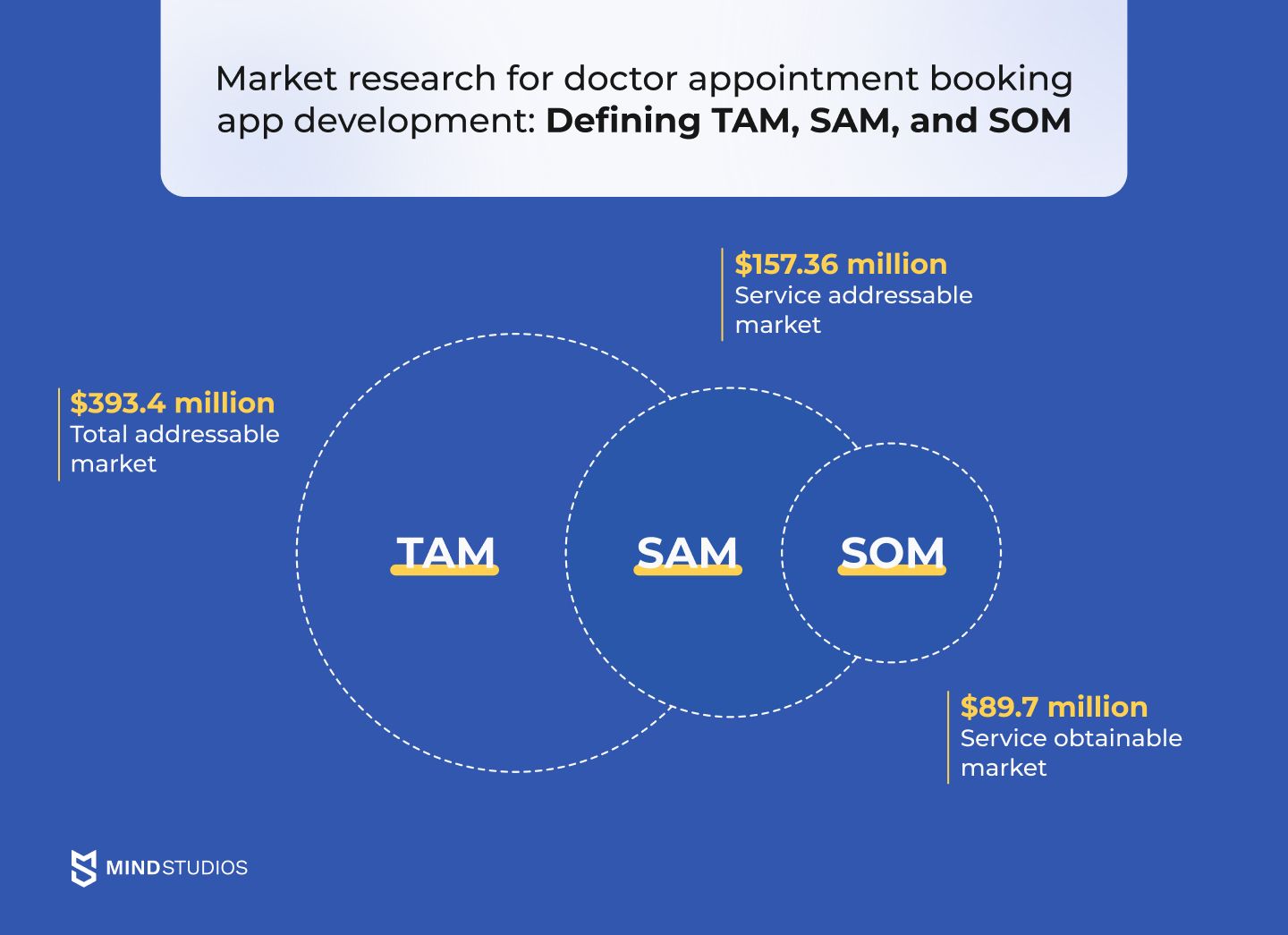
If your practice is in the US, here are some figures to consider:
- The total value of the global medical appointment scheduling software market is expected to reach $393.4 million in 2022, which can correspond to your total available market (TAM).
- Accounting for a 40% share of this global market, the appointment scheduling software market in the United States is predicted to reach $157.36 million in 2022, which will correspond to your serviceable available market (SAM).
- 57% of US patients prefer to use mHealth apps for communicating with physicians and medical staff, cutting your serviceable obtainable market (SOM) to $89.7 million.
If you succeed in capturing even 0.5% of the SOM market share with your new online doctor appointment booking software, your annual revenue from the app alone could reach $448,500.
However, your market share is an unknown variable. It could be as high as 10%, or as low as 0.0001%. To assign it a realistic value, you need to have a clear picture of how much competition there is in your niche and who your direct competitors are.
Competitor analysis
If you plan to bring your custom online doctor booking app to the US market, for instance, you might discover that platforms for established patients (so-called patient portal apps) of the top 20 US hospitals have a lot of flaws related to scheduling appointments:
- Only a third of the top 20 hospitals allow new patients to book appointments without creating an account.
- Only eight healthcare providers allow new patients to schedule in-person visits online, and only seven allow new patients to schedule virtual appointments online.
- Beyond primary care, only 10% of the top 20 health systems in the US offer online scheduling for broader healthcare services like urgent care, laboratory and diagnostic care, vaccines, and mental health care.
- Only one of the top 20 hospitals in the US indicates which providers have upcoming availability and showcases real-time availability in search results.
By conducting competitor analysis, you’ll be able to identify the mismatches between existing online doctor appointment scheduling solutions and patients’ demands, which can give your app idea a solid shot at success, assuming it’s implemented well.
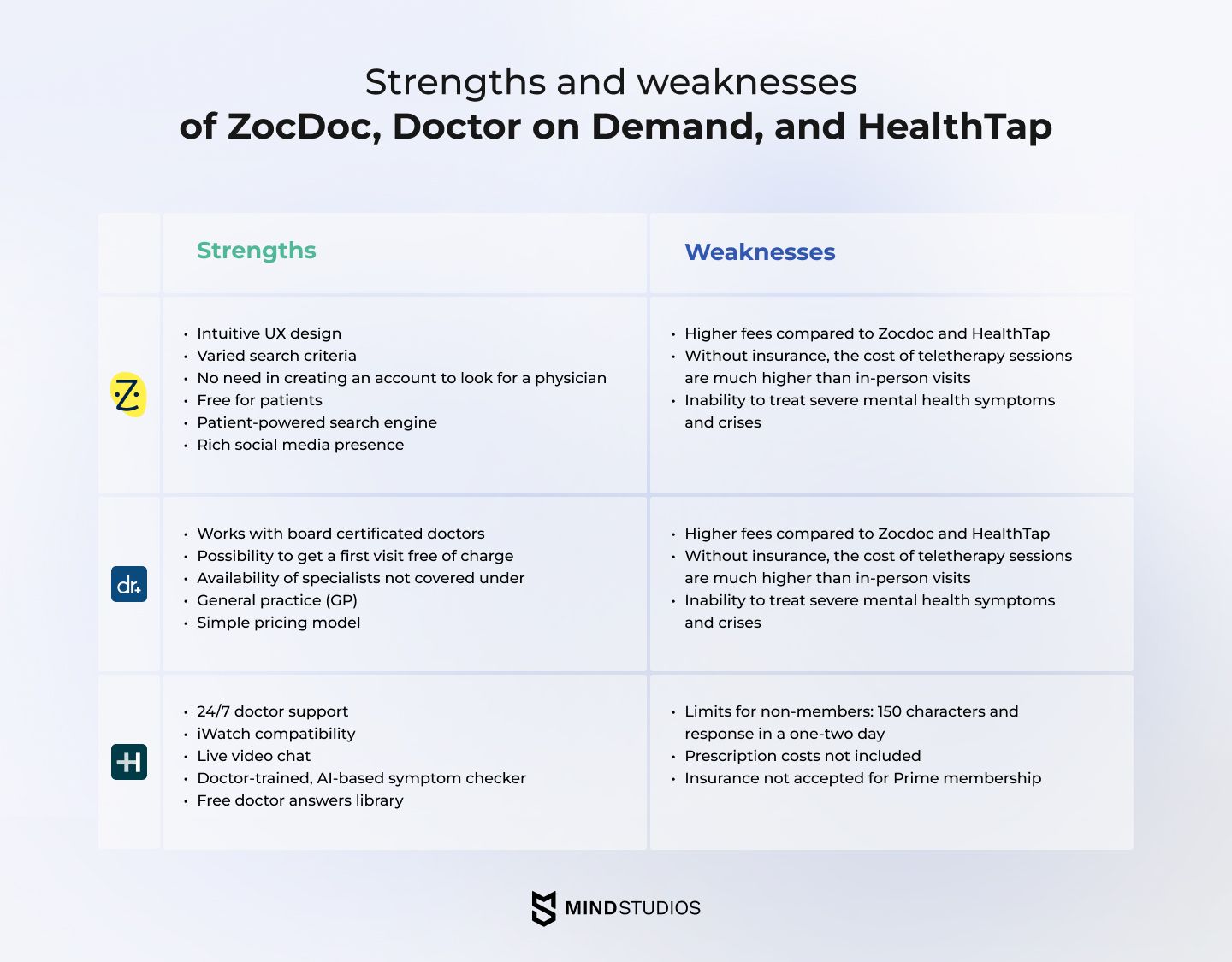
User analysis
Analyzing your target users can give you the most valuable insights into what functionality your app should provide. You can analyze insights from:
- Your patients (established, new, those who recently left your clinic)
- Your medical staff (current, newly hired, recently resigned)
- Competitors' users who have left reviews (especially negative)
We’ll assume your clinic is already equipped with some sort of customer relationship management system (CRM) and that you’re clear on the demographics, in-market behavior, psychographics, and preferences of your target patients.
With your patients and medical staff, you can conduct interviews, create focus groups, and run polls to find out what they expect from your doctor appointment booking mobile app.
But what about new users? Let’s consider an example of a patient persona using data from the Kyruus Patient Access Journey Report 2022:
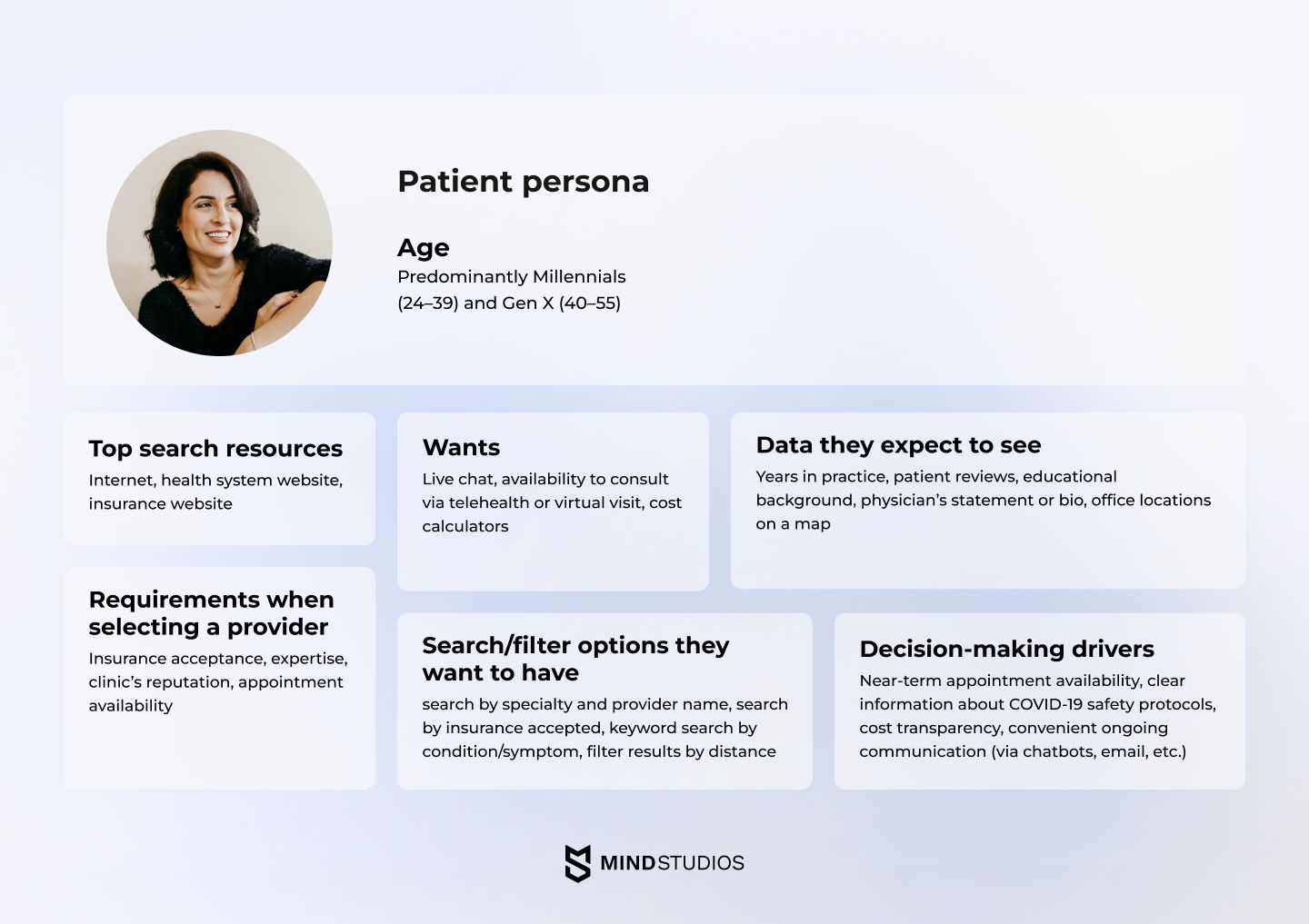
In addition, it’s often helpful to analyze user reviews of competitors’ apps to determine what features you must or should include in your doctor appointment app.
Step 2. Prioritize app features
Only a thorough competitor and user analysis can solidly prepare you for deciding what features you must, should, could, and won’t include in your app (the MoSCoW prioritization matrix). Apart from this one, there are at least eight other methods for prioritizing mobile app features.
Let’s describe what features of an online doctor appointment booking system can form the backbone of an app for your clinic:
Sign in/Sign up
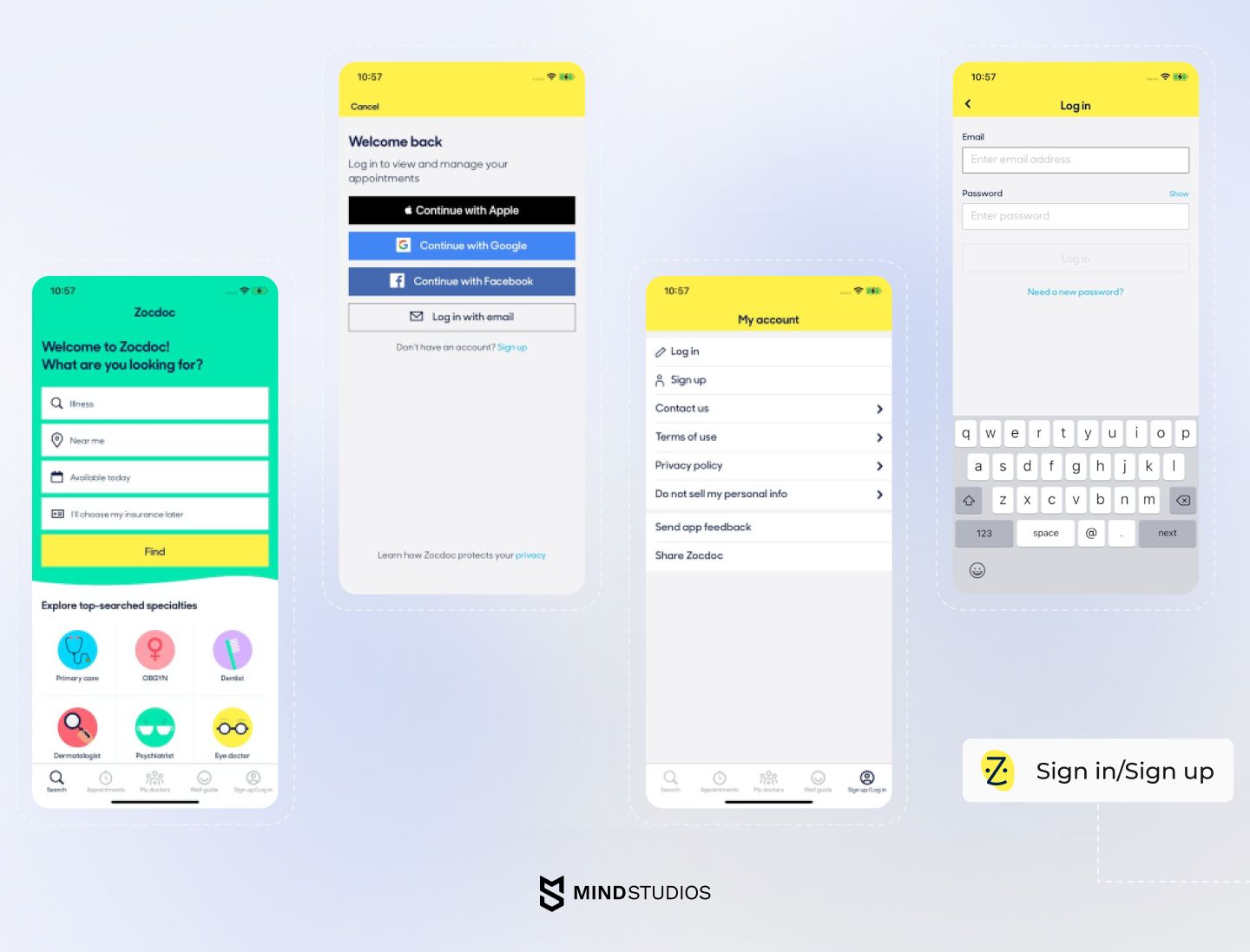
Provide secure and easy in-app registration, allow users to sign up with their Google account, Apple ID, email, phone number, or organization credentials.
Consider putting a sign-in/sign-up form to the end of the navigation bar. Zocdoc’s first screen is a search bar. They moved the tab with a sign up/log in form to the end of the navigation bar. It seems a wise design solution to protect first-time users from 5+ screens of form-filling, mitigating the risk of user exhaustion.
Patient account
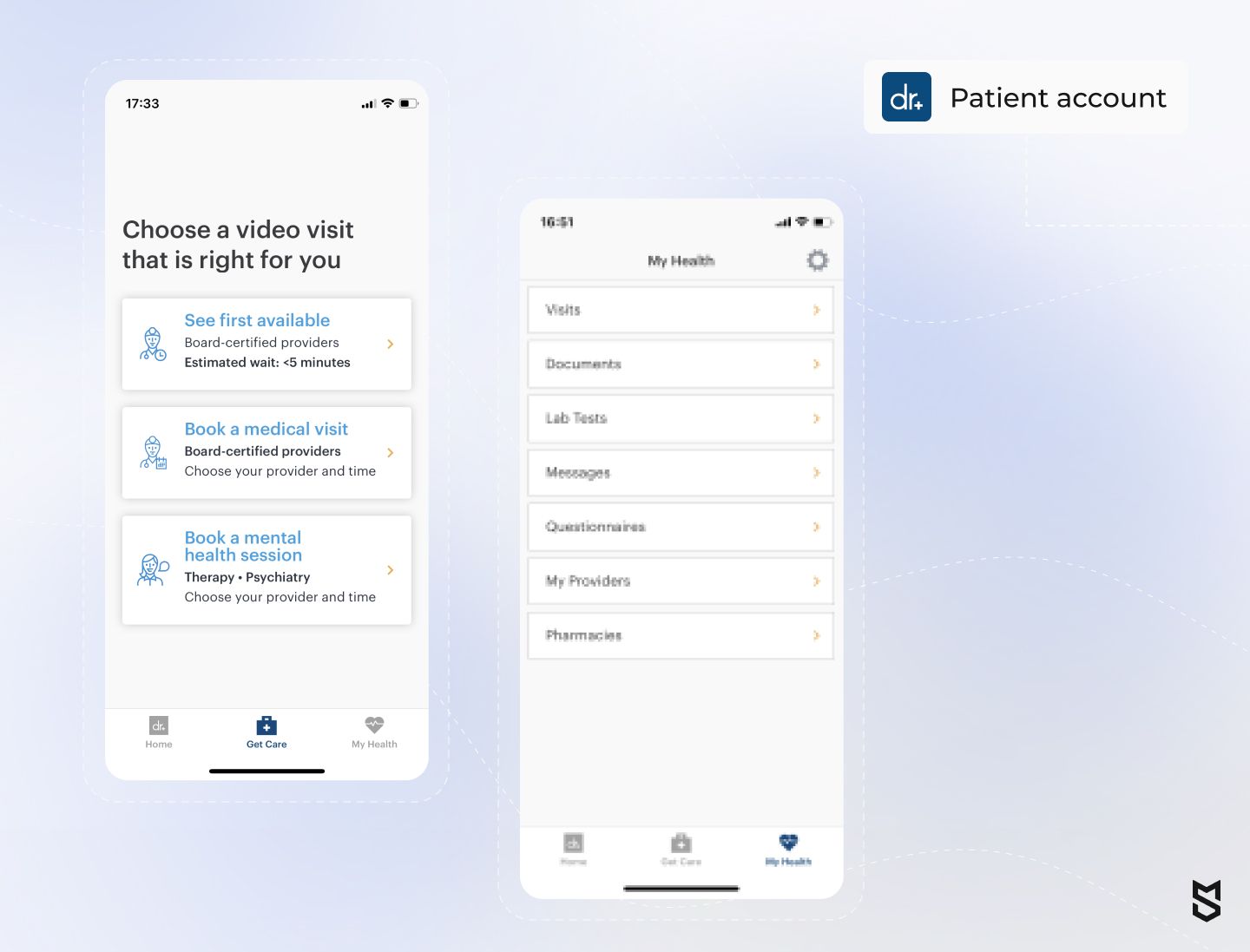
With an account in the appointment app, patients can manage personal information, view visit/payment history, change passwords, save health-related documents, and sign out. Thanks to a patient account, doctors can examine initial patient data (e.g. medical histories, lab tests) before an appointment.
A good example is Doctor On Demand’s patient account which includes two blocks: “My account” and “My health.” Using the “My account” settings, patients can:
- Change contact information, passwords, insurance plans, employers, and Google Fit settings
- Choose a payment method
- Apply a coupon for a free first visit or share their own promo codes
- Get in touch with customer support or send feedback
In the “My health” section, patients can store visits, documents, lab tests, messages, questionnaires, providers, and pharmacies.
Symptom checker
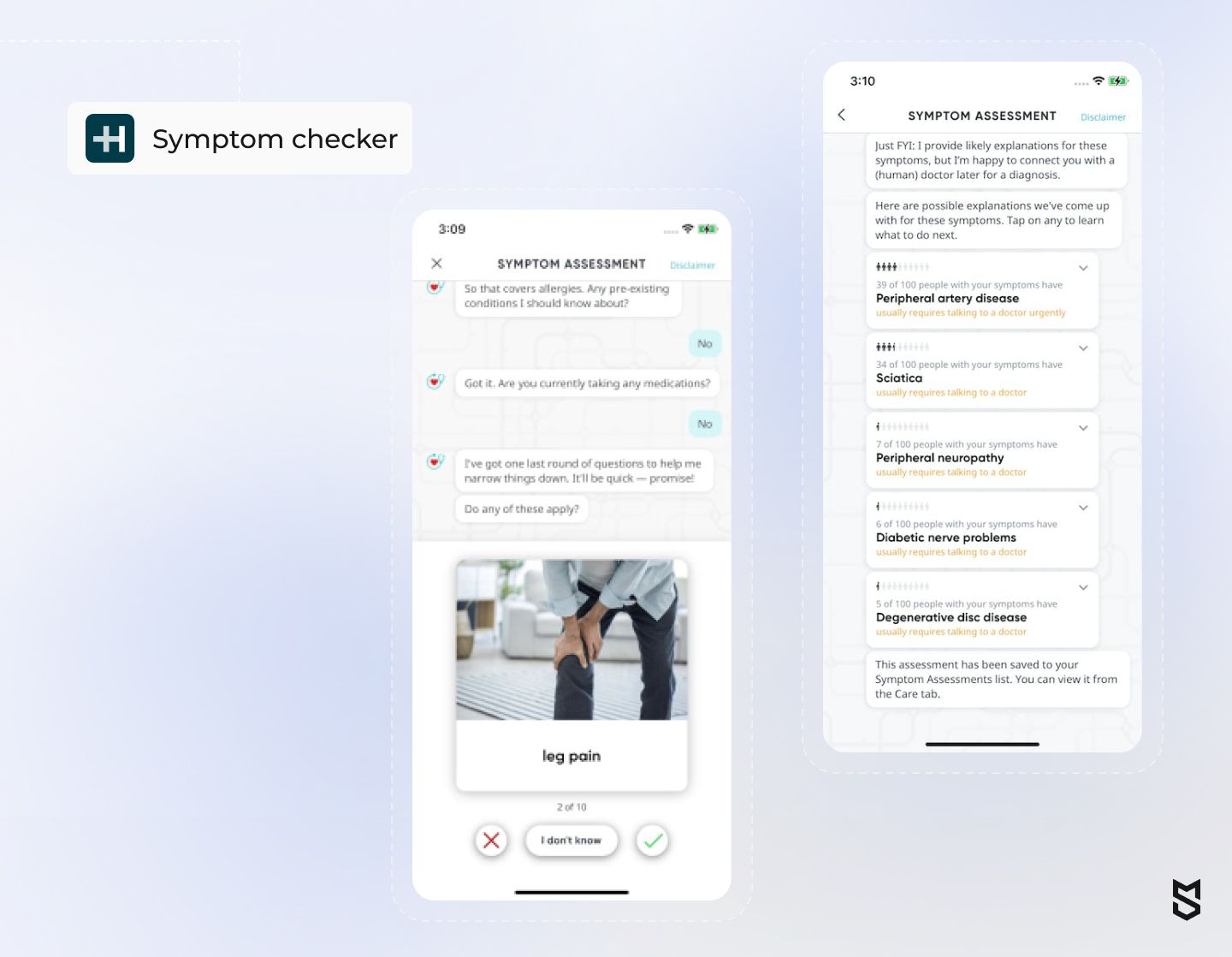
From our survey for a new mHealth project for the US market, we concluded that 37% of patients feel uncertain about what specialist they need. It's worth introducing something like a symptom questionnaire into your online appointment system to help your patients find the right doctor.
See how effectively the HealthTap symptom checker gets the job done. It’s an in-app AI-powered chatbot that transforms patient symptoms into diagnoses and offers patients options for what they can do next: book an online consultation, visit a clinic, post a question, or read educational content.
Search
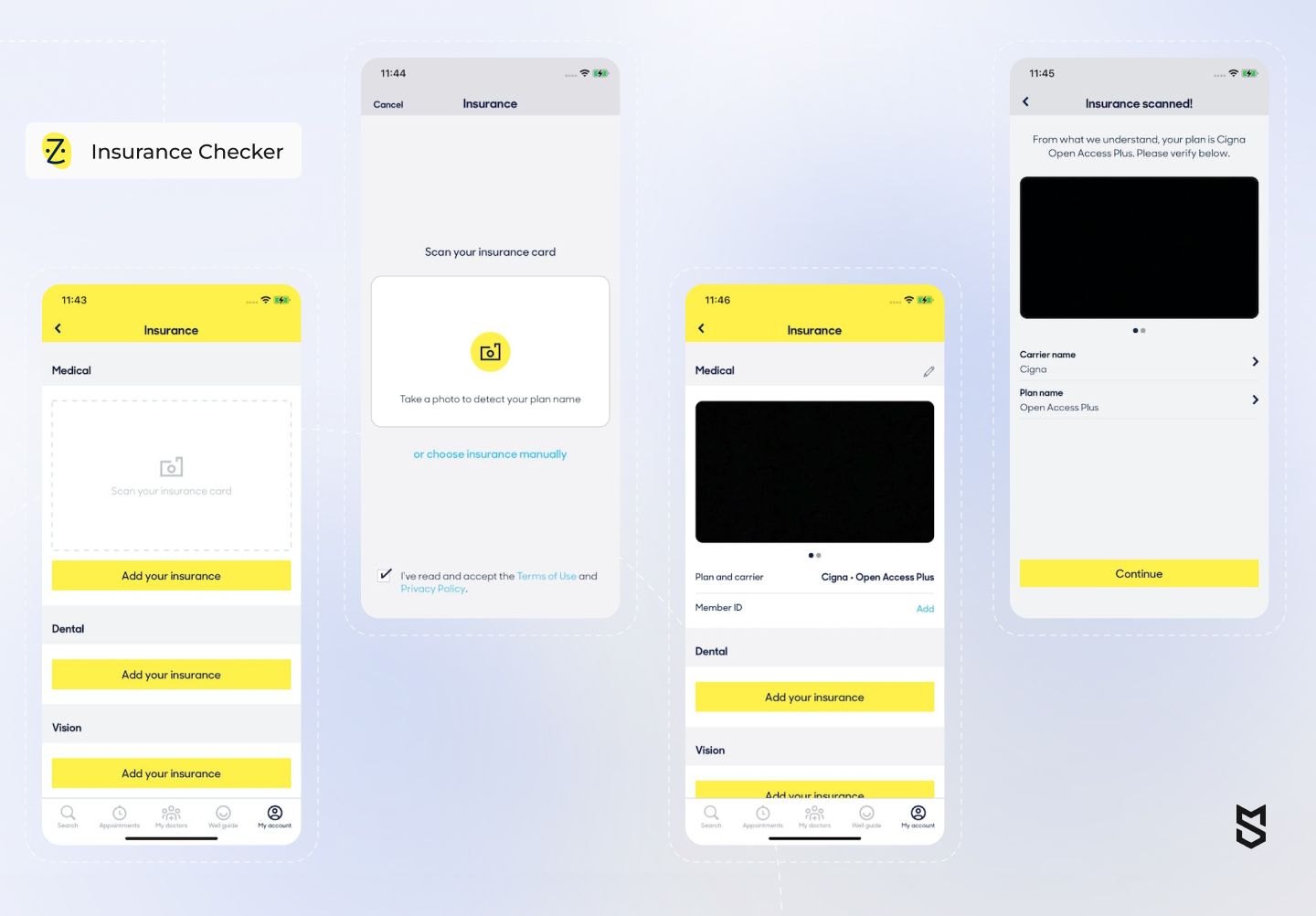
Allows users to search for a doctor by specialty, symptom, condition, treatment, name, and insurance acceptance.
It will be convenient to have a photo scan feature that allows users to scan their insurance cards and automatically detect insurance plans.
List of available doctors
In a doctor appointment app, searching for a health provider tends to lead users to a feature-packed list of doctors.
Consider including doctor names, photos, specialties, locations, available doctor appointment slots, and ratings in your app’s doctor list.
Filtering
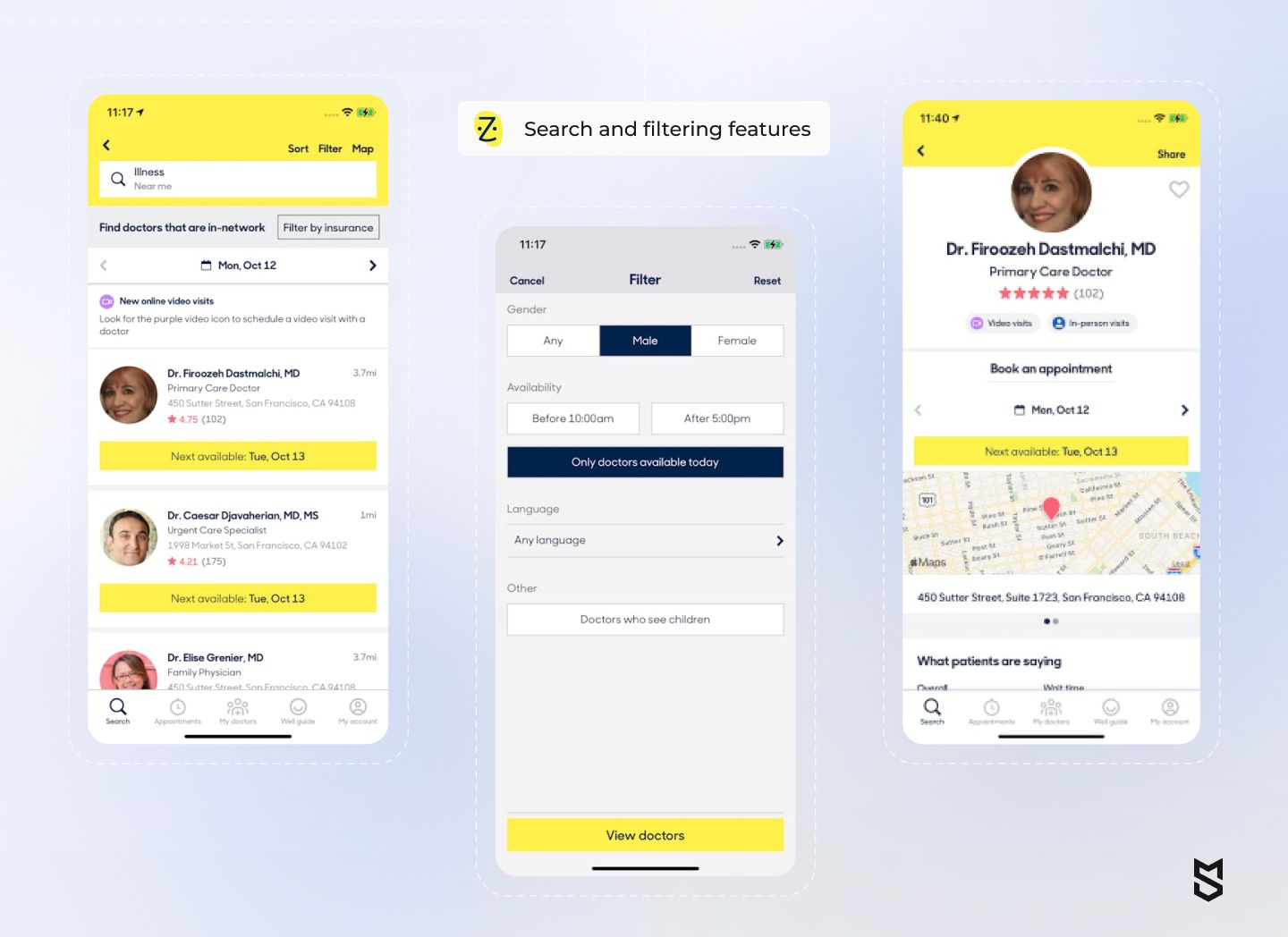
After viewing a list of physicians, users need to be able to filter them by different parameters.
Filter parameters for doctors can be distance, availability, gender, languages spoken, whether they see children/adults only, or a virtual visit option (if you plan to provide one).
Map
If your clinic is part of a network of medical facilities, it’s sensible to show locations with available doctors on a map. Also, you can add locations of nearby pharmacies.
You can highlight the nearest locations and indicate which mode of transport can be used to reach them.
Doctor profiles
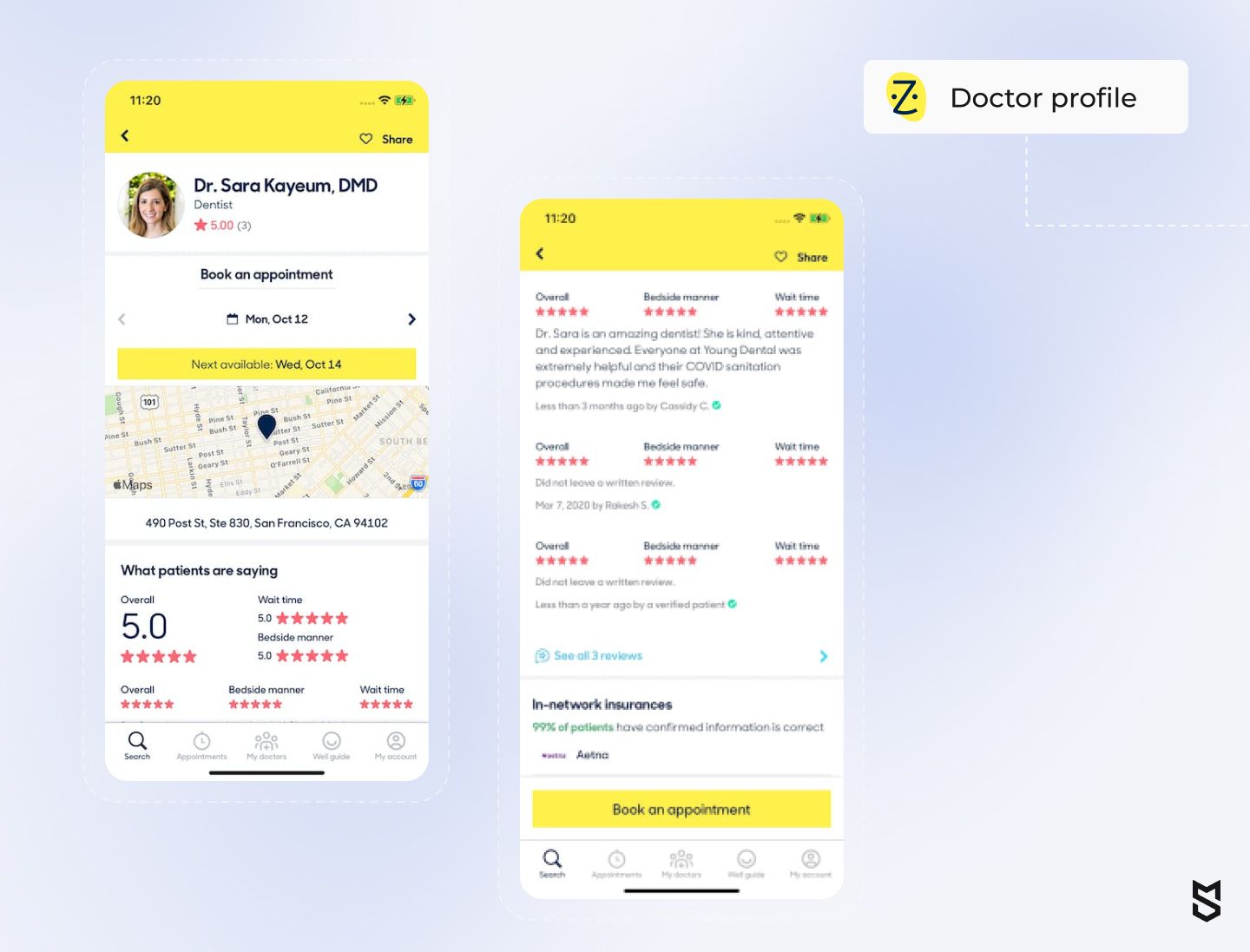
Apart from a common doctor list, enable users to get more specific data about each physician. Doctor profiles should contain a doctor’s bio along with information on years of experience, license
s/ certificates, education/training, affiliations, languages spoken, virtual visit availability, contacts, etc.
HealthTap added a Q&A section to doctor profiles and also a separate section for reviews of a doctor’s virtual visits. You can also help doctors track their progress and depict real-time performance indicators in doctor appointment app dashboards and reports.
Online appointment booking
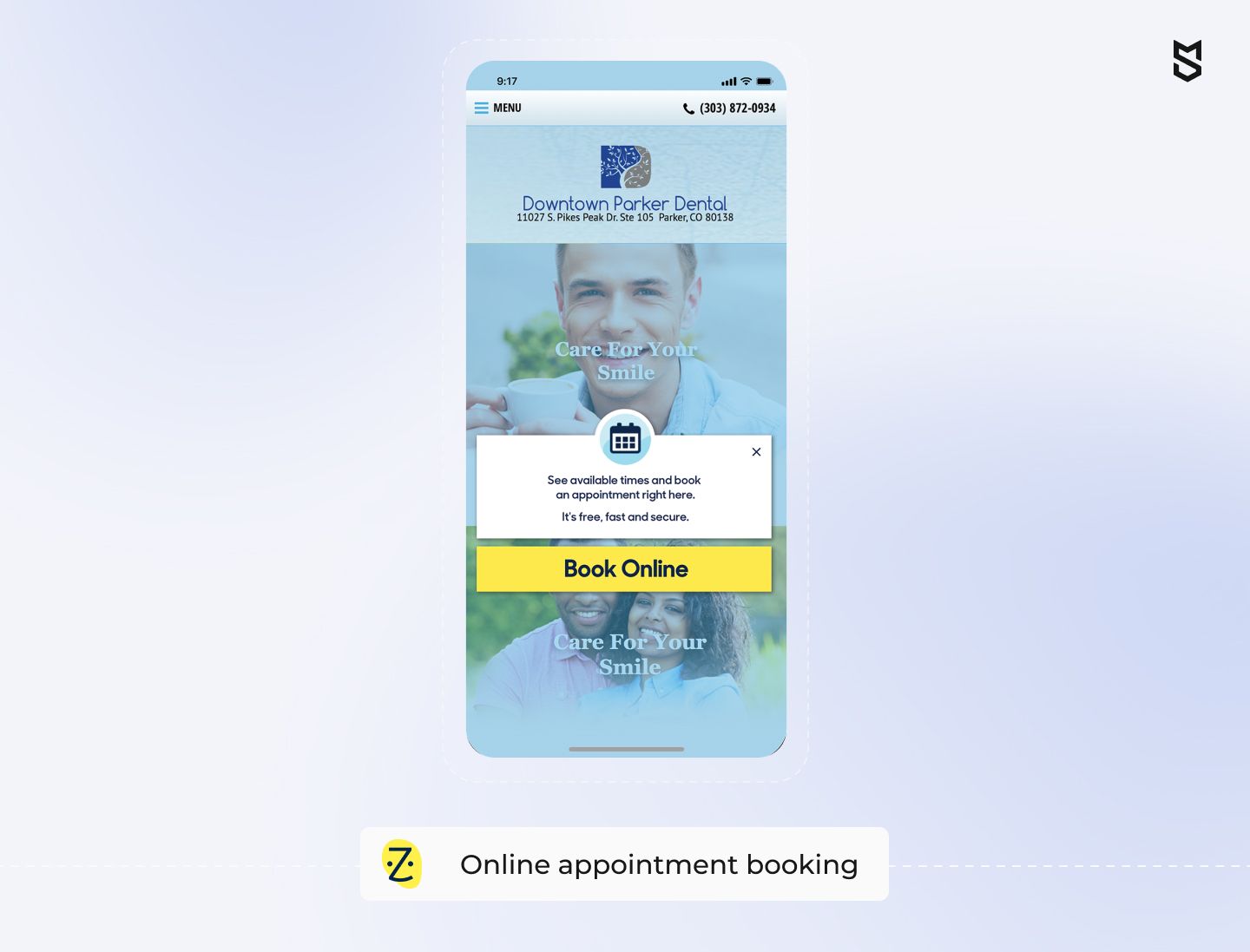
Booking appointments for first and follow-up visits is your doctor appointment app’s primary use case, so functionality for doing this must be seamless and intuitive.
Consider adding a contrasting button with understandable text, as Zocdoc did. The “Book online” button in Zocdoc has become so recognizable that it’s now available for adding to Squarespace websites.
Online appointment management
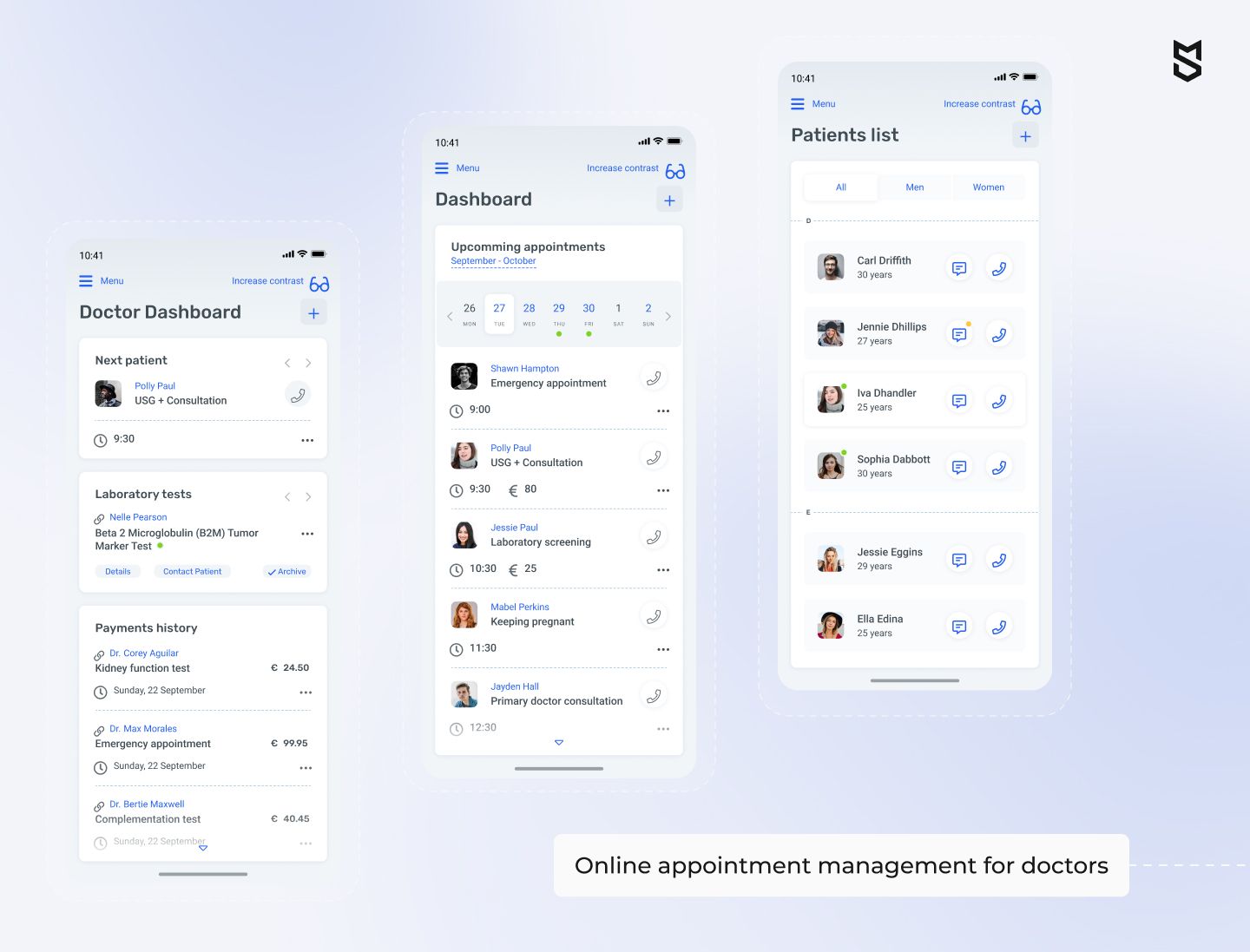
Allow patients to easily book, change, and cancel appointments. Enable doctors to check appointment statuses and accept or reject appointments in your app.
Consider adding a calendar to help patients book/rebook follow-up appointments and allow doctors to see their slots.
Reminders & notifications
To be effective at reducing patient no-shows, reminders about upcoming appointments must be timely and tailored.
You can choose the following frequency of in-app reminders:
- Immediately after an appointment is scheduled
- Around 24 hours before an appointment
- One hour before an appointment
Online prescriptions
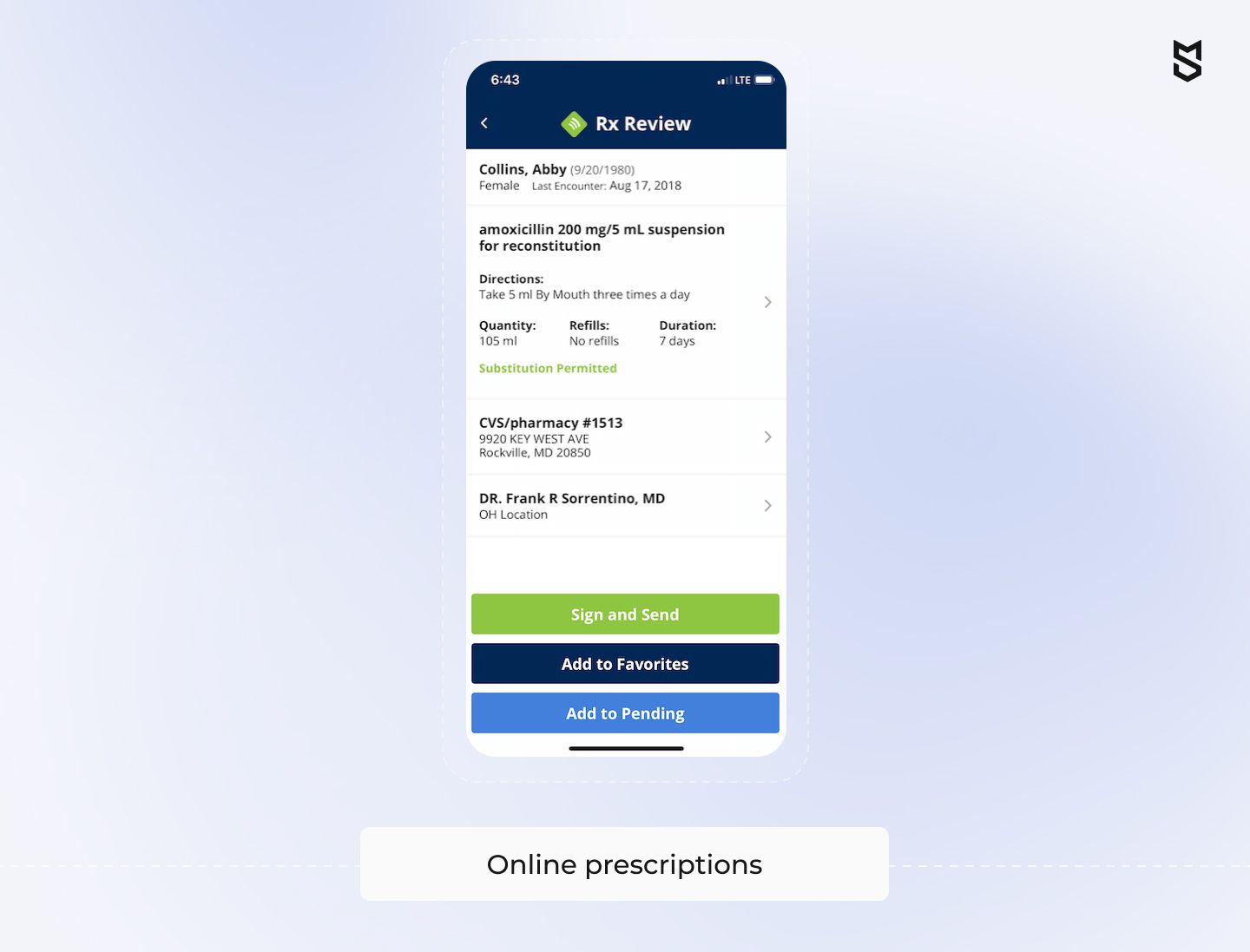
Within your app, you can:
- Enable doctors to create e-prescriptions for patients
- Send e-prescriptions to patients’ chosen pharmacies
- Store e-prescriptions in patients’ accounts
Keeping in mind one of the negative reviews that Doctor on Demand has recently received, consider storing the history of all e-prescriptions in patient accounts no matter what stage of treatment a patient is at. Doctors tend to erase prescriptions after patients pick up medications.
eBilling & Payment gateways
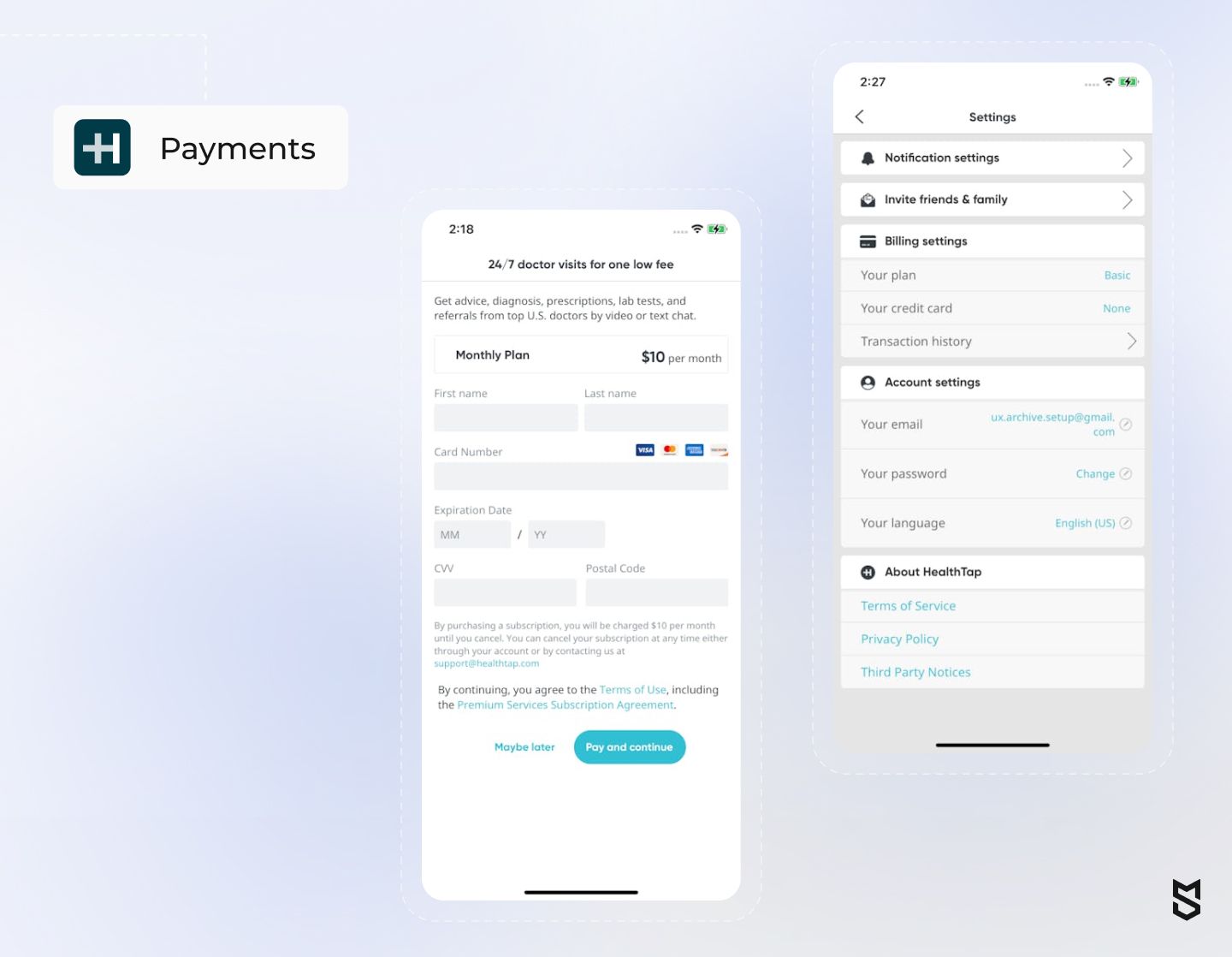
Allow doctors to create online bills and patients to pay via credit card or a payment gateway within your doctor appointment app.
The most popular payment gateways in the US that you can use in a doctor appointment app are Stripe, Paypal, Authorize.Net, AmazonPay, and WePay. Read more about mobile app payment gateway integration.
Reviews
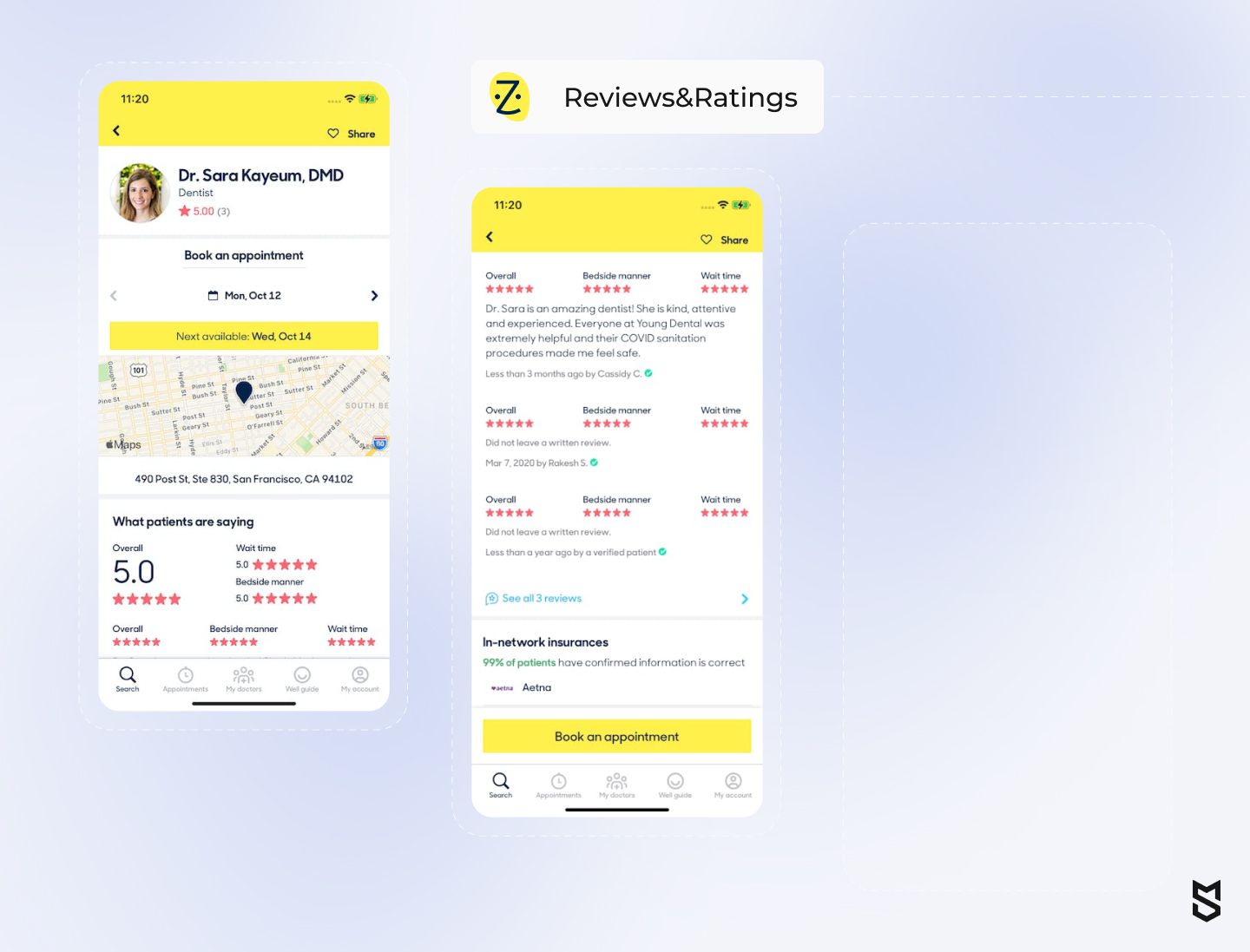
Allow patients to review their past appointments and rate them by specific criteria.
Criteria for rating doctors include wait time, expertise in diagnosing, prescribing the appropriate drugs, communication style, level of empathy, etc.
Admin panel
An admin panel is necessary for you to approve doctor profiles, manage doctor profiles and patient profiles, monitor bookings, publish reports, and control your app in general.
Only you (as the app owner) and a couple of designated people will have access to the admin panel using a secure login and password.
Once you’ve decided on what doctor appointment app features to develop first, think of features that can boost user engagement and make your doctor appointment app extremely valuable. In most cases, such features are costly or time-consuming to build, so you can put them into a backlog to consider for further development.
So if you’re thinking of how to develop an online doctor appointment app for your clinic that is more advanced, consider implementing the following features:
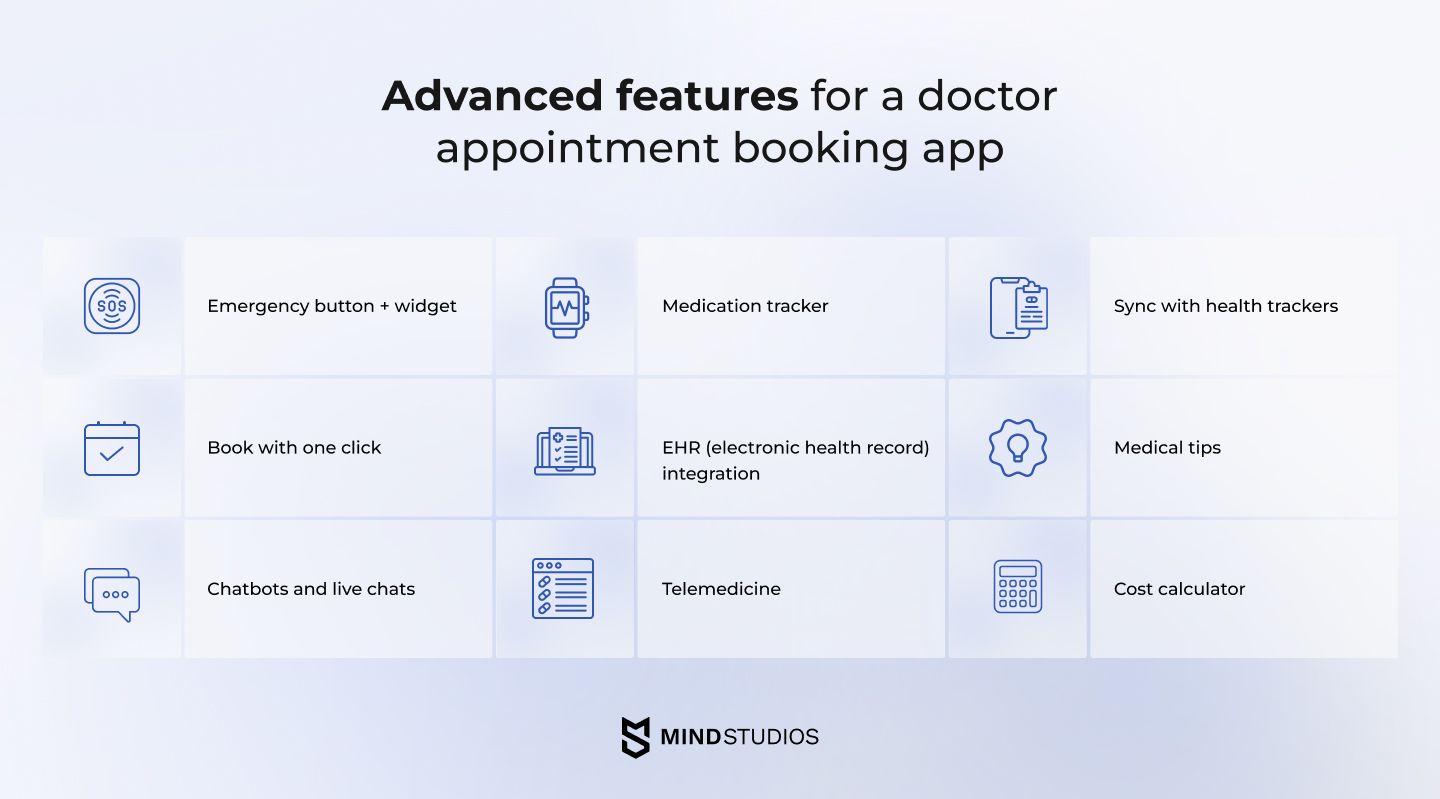
- Emergency button + widget. This feature enables patients to send a distress message to your clinic in one go which is useful for those who need immediate doctor help.
- Book with one click. Modern users appreciate performance and simplicity in mobile apps, and a doctor appointment booking app is no exception. Allow yours to let users choose a doctor in seconds. If a patient abandons the appointment app without completing an appointment reservation, it makes sense to pop up a prompt “book” feature once they open the app next time.
- Chatbots and live chats. A chatbot for answering standard healthcare questions and a live chat for answering queries that require human intervention — to create a doctor scheduling app with high-quality patient support, consider including both.
- Medication tracker. One more useful feature which will likely be appreciated by your patients: the app will send notifications for patients to take medications and update prescriptions.
- EHR (electronic health record) integration. With your appointment app for doctors, you might consider providing doctors and patients with access to patient medical and treatment histories, diagnoses, treatment plans, medications, lab tests, and more. To do this, you need to integrate your doctor appointment app with your clinic’s electronic medical records (EMRs) or electronic health records (EHRs). Epic, Athenahealth, and Nextgen are good examples of top EHR software vendors.
- Telemedicine. To expand your custom doctor booking app functionality for patients preferring online consultations, you can develop a telemedicine feature.
- Sync with health trackers. Nowadays, fitness bracelets, smartwatches, and smart rings track people's core health parameters: body temperature, blood pressure, heart rate, etc. This up-to-date data can be useful for doctors to stage initial diagnoses. By making your app sync with health trackers, you can increase user engagement of both patients and doctors.
- Medical tips. To add more care about patients to your doctor appointment app, you can provide them with personalized medical tips during their treatment journey that will help them avoid mistakes and recover faster.
- Cost calculator. Visits to doctors may be of different lengths, first or subsequent, with or without insurance coverage. All this impacts the cost. Consider implementing a cost calculator to give patients a clear picture of how much they will need to pay for their doctor visits.
Step 3. Define your app’s revenue sources
To help you clarify how to build an online doctor appointment booking system that will make a profit, we’ll explore the ways existing apps of this type make money.
Zocdoc is absolutely free for patients and gets payments from healthcare providers. In 2018, physicians needed to pay a $3,000 annual subscription fee. To become affordable for suburban, rural, and other providers with few patients on the platform, in 2019, Zocdoc changed its pricing policy. Now physicians need to pay a $299 annual licensing fee and pay from $35 to $110 for each new patient attracted through the Zocdoc app.
Doctor on Demand boasts the simplest pricing policy because it requires patients (or more likely, their insurance companies) to pay for online consultations based on their length:
- 25-minute medical care consultation — $129
- 50-minute therapy session — $179
- 45-minute initial psychiatrist consultation — $299, with $179 for a 15-minute follow-up
- 50-minute psychologist consultation — $179
HealthTap offers two types of membership. The first, called HealthTap Prime, costs patients $15 a month and allows them to book appointments for $39 per visit. If patients have insurance, their provider can cover 50% of this cost for each in-person or virtual visit, leaving a $19.50 copay. If a patient is a member of the HealthTap Basic plan, they pay $80 for one visit or $40 if paying a copay.
How can you define what monetization model will suit your business goals best? First of all, you can discuss the doctor appointment app pricing policy with your dedicated employees. Then, make a preliminary calculation of your unit economics and find out what service fees can facilitate a breakeven point. Somewhere in the middle of qualitative and quantitative feedback you’ll find the best solution.
Step 4. Identify constraints
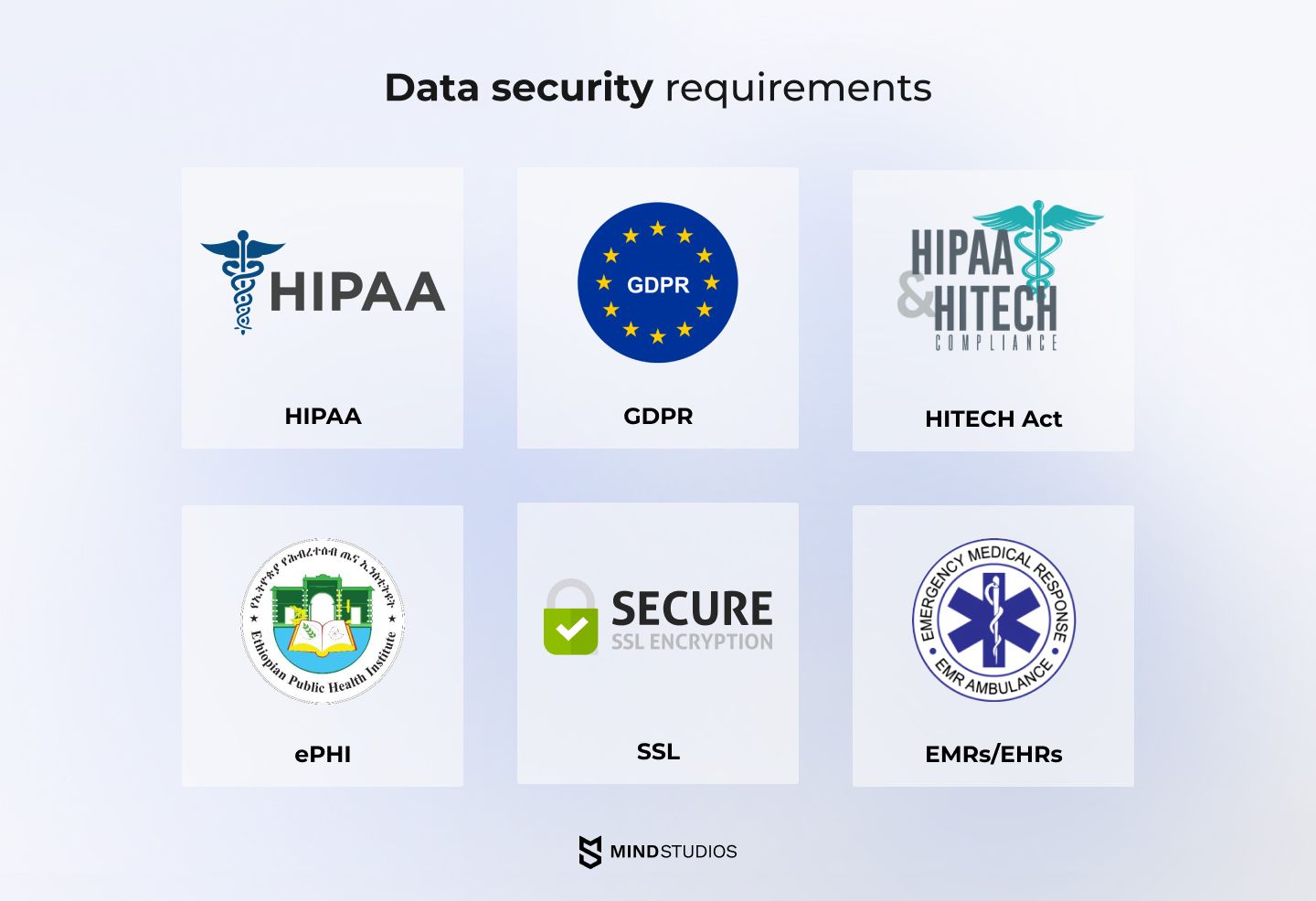
Your doctor appointment app, like any other healthcare-related software, needs to transmit, receive, store, and alter electronically protected healthcare information (ePHI). But how can you make a doctor's booking app reliable? For protecting privacy and security, your app’s architecture should align with requirements dictated by the following:
- Healthcare Insurance Portability and Accountability Act (HIPAA)
- General Data Protection Regulation (GDPR)
- Health Information Technology for Economic and Clinical Health Act (HITECH Act)
- Protected Healthcare Information data encryption (ePHI)
- Secure Sockets Layer (SSL) connections
If you enrich your doctor appointment app with virtual care and telemedicine features, then you need to conform to the telehealth regulations and reimbursement policies in your state.
Step 5. Choose a mobile app development company
Cost is a solid decision driver, but sometimes it shouldn’t be the only consideration. Choosing a mobile app development team is one of those instances when it shouldn’t be. We’ve posted a lot of articles about the cost to outsource app development and steps you should take to find professionals.
Here, we’ll share one core tip for checking whether a company is a trustworthy partner. Before formalizing your agreement, give a potential development team a small test assignment. It can be drafting mobile app product requirements documentation, creating an app logo, or outlining initial mockups of onboarding screens. This trial collaboration will give you valuable insights into the team’s:
- Ability to meet deadlines
- Communication skills
- Ways of solving issues
- Ability to match an agreed price
- Technical skills
- Level of quality provided in the end product
If something goes wrong with this small task and you don’t choose this team, it won’t cost you the success of your entire medical appointment app development project.
Step 6. Design & develop
Here we come to the most labor-intensive part of the process — the design and development of an online doctor appointment booking system. Let’s sort out the essentials to make this stage run smoothly.
Prepare a doctor database
Everything is simple here: you can take your clinic’s existing database of medical staff and incorporate it into the new appointment software or use third-party APIs of publicly available doctor databases like BetterDoctor Rest API.
Decide on a scheduling engine
The core of any doctor appointment booking app is a scheduling engine. A few years back, when there was no abundance of third-party scheduling APIs, we at Mind Studios had been building this functionality from scratch. Making it maximally fine-tuned to the project requirements took us many hours to develop and cost our clients a pretty penny.
Now, we can offer you an efficient alternative.
“One of the most time-consuming and costly chunks of doctor booking app development is building a scheduling engine from scratch. However, there’s another, cheaper approach — integrating a third-party scheduling API like those provided by Calendly. By using a scheduling API, we can speed up the doctor appointment booking app development process and reduce costs for our clients. It will impose some limitations on the UI, though.”
— Anton Baryshevskiy, Mind Studios Co-founder and Head of Business Development
Work on UI/UX design
If you try to create your own HealthTap patient account, you might be confused a bit when entering your year of birth using the calendar. To pick a specific year from a list instead of manually swiping the calendar pages, you need to tap the year area, though this area of the user interface doesn’t seem interactive. There are no arrows and no hints.
If users have to guess something while using an app, it’s an indicator of a bad UX design. To avoid this, make sure to meticulously and rigorously break down each step your users will take while interacting with your app; use mockups and prototypes to clearly see results.
The outcome of the designer’s work is a high-fidelity app prototype that developers then turn into a minimum viable product (MVP) or minimum lovable product (MLP).
Choose an appropriate tech stack
To help you learn how to develop a doctor appointment app from the technical side, we’ll share the basic tech stack our developers use for building doctor appointment scheduling software:
- Mobile app development: Swift (iOS), Kotlin (Android)
- Frontend development: Vue.js
- Backend development: Ruby on Rails
- Database: MySQL, PostgreSQL, MongoDB
- Cloud environment: Google Cloud, Amazon Web Services (AWS), Microsoft Azure
- Payment gateways: PayPal, Stripe, Braintree
- Maps and user location tracking: Google Maps API, MapKit, CoreLocation
- Scheduling engine: Calendly API
- Push notifications: Twilio, Push.io
- In-app calls and messages: Twilio
Step 7. Test & improve
How to build an app for booking doctor appointments hassle-free? While designers are drawing user-friendly app screens and developers are turning pixels into high-quality code, quality assurance (QA) specialists need to check intermediate results and let the team know about bugs in a timely manner.
To be sure the final product will meet your doctors’ and patients’ expectations, the team should run features through A/B testing. They can ask your medical staff or patients dedicated to your clinic to try features A and B in your appointment app and give feedback on which works better.
Before launching an MVP, QAs should check all app functionality, including through stress testing, unit testing, and security testing. The process of testing and improving continues as long as your app is live.
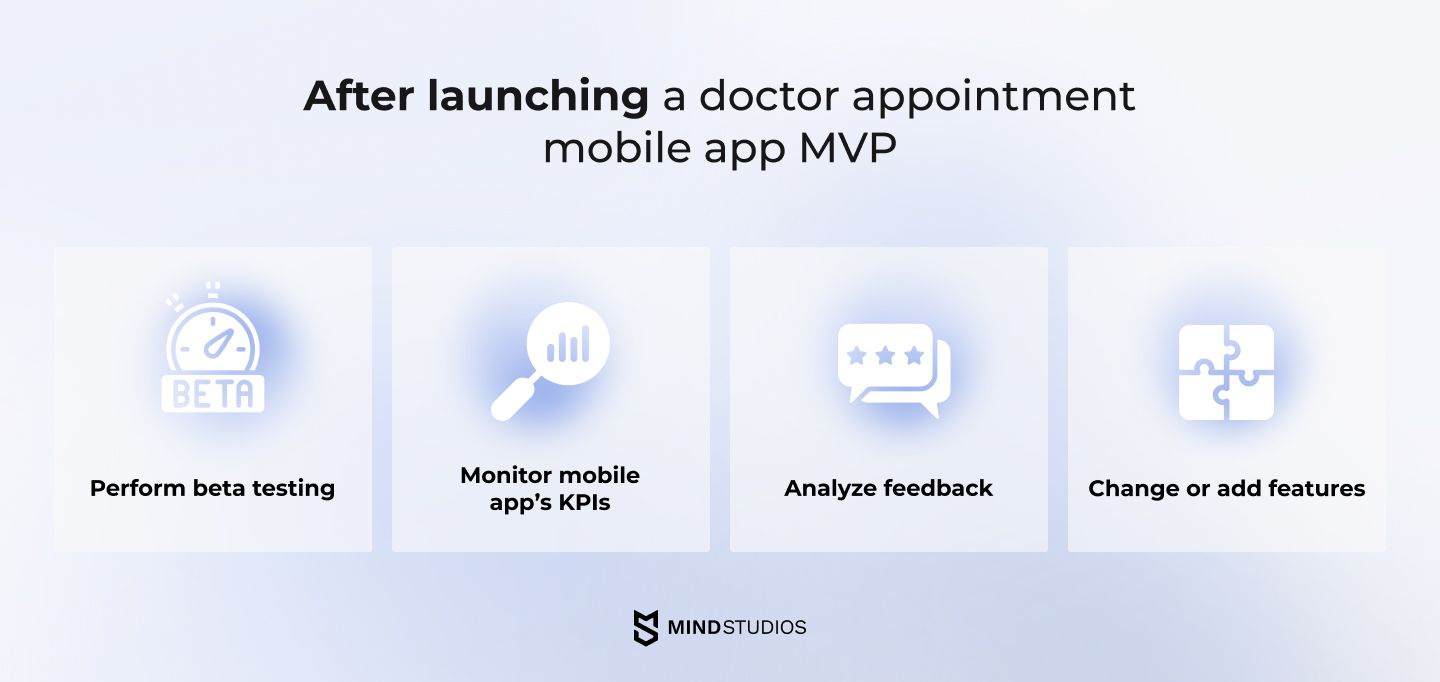
Effective marketing strategies
Doctor on Demand uses a referral program, enabling patients to share promo codes and get their first online consultation for free. Zocdoc allows doctors to promote themselves by paying for in-app advertising in Sponsored Results. HealthTap actively promotes its services among enterprises and insurance companies.
Still, several potentially effective ways to market your clinic appointment booking app remain unexplored:
- Collaboration with influencers related to the healthcare industry
- Video blog on YouTube (for example, to show your clinic behind the scenes)
- Activities on social media networks: Facebook, Instagram, LinkedIn
- Promotional landing pages
- Paid advertisements
- Partnership with pharmacies
Note that marketing strategies can vary depending on the type of software you use (e.g. software as a service application) or specific clinic requirements for a mobile app, for instance.
On-demand doctor appointment app development cost
The cost of online doctor scheduling app development may vary depending on the number of platforms it supports (iOS, Android, web), feature complexity, design requirements, tech stack, the size of the mobile app development team, and their hourly rate.
For online scheduling mobile appointment app projects, Mind Studios tends to assemble teams of the following specialists:
- Project manager – 1
- Business analyst – 1
- UI/UX designer – 1
- iOS developer – 1
- Android developer – 1
- Backend developer – 1
- QA specialist – 1
So how much does it cost to build an app for booking doctor appointments? Since we aren’t familiar with your specific project requirements and objectives, we can only give an extremely approximate estimate. It will take at least 6 months and $159,900 to build a doctor appointment scheduling app with basic features running on two platforms.
What lies behind this price? See details in the table below:
| Stage | Time (hours) | Cost (USD) |
|---|---|---|
| Discovery stage | 100+ | 4,500 |
| UI/UX design | 160 – 220 | 7,200 – 9,900 |
| iOS development | 860 – 920 | 38,700 – 41,400 |
| Android development | 880 – 940 | 39,600 – 42,300 |
| Back end + admin panel | 900 – 980 | 40,500 – 44,100 |
| Quality assurance | 440 – 470 | 15,400 – 16,450 |
| Project management | 400 – 440 | 14,000 – 15,400 |
| Total | 3,740 – 4,070 | 159,900 – 174,050 |
The way you’re going to bring your online doctor appointment scheduling app to market also impacts the cost of development. If you have a lean budget, a soft launch will be your go-to option.
The Mind Studios experience
Now let’s highlight the functional modules our developers have successfully implemented working on projects with a scheduling functionality at their core:
Custom scheduling calendar, eBilling, and in-app payments
Edify was intended as a two-side marketplace where specialists in different fields could provide consultations to their clients. Therapists, oncologists, auto mechanics, English coaches, etc. — the system validated specialists of all kinds by requiring them to upload their IDs, licenses, and other work permit documents. Then, specialists set their hourly rates and got to Edify’s listings.
With the help of search and filtering, users could find a required specialist by examining their descriptions and ratings. To enable users to schedule an appointment with a suitable expert, each specialist had set their available slots in the calendar. And when someone booked an appointment, the system marked that slot as occupied.
Our custom scheduling solution for Edify was built from scratch. Also, we integrated it with experts’ personal calendars so that they received notifications from all their calendars in one place.
For Edify, we integrated an eBilling and payment functionality into the appointment app. After a session was over, the system counted the exact amount of consultation time, calculated the price based on the specialist’s hourly rate, and then offered users to pay for the consultation using their credit cards.
Symptom checker, e-prescriptions, and integration with pharmacies’ CRM
For users of ClearSkin Concierge, an online dermatology telemedicine platform, we created an interactive questionnaire (symptom checker). Based on the user’s answers, it allowed identifying which skin problems a user had and automatically recommended an appropriate treatment.
With a paid subscription, a user could schedule an appointment with a dermatologist and get online consultation via a chat using text messages, photo-sharing, or live calls and revise the treatment the system offered or get extra recommendations.
Moreover, ClearSkin Concierge provided users with online prescriptions alongside treatment. To ensure the e-prescriptions the system generated would be accepted by particular pharmacies,
we integrated ClearSkin Concierge with the pharmacies’ CRM system using the RX data integration tools.
That way, users were aware of the availability of prescribed medications in local pharmacies and could easily order medications and pick up their orders from the pharmacies nearby.
Since the platform operated with a lot of sensitive user information, we made the software HIPAA compliant: no emails for data transmission with a password-protected environment. To develop an online doctor appointment scheduling app secure and safe, we created an admin panel where doctors can access patients’ information only after successfully logging in.
Video chat, exchange of documents, and emergency button
Gadh, a mobile-only lawyer consultation service, was for users who got into some urgent situations like car crashes and needed an instant consultation with a lawyer. We implemented a calendar where users could schedule a call with a lawyer. With an activated subscription, users could call a lawyer immediately just by tapping a button.
To allow users to provide lawyers with comprehensive information about what had happened, we created photo- and document-sharing features. In addition, we developed a video chat for online consultations using WebRTC, TopBox(Vonage) API, and Twilio for real-time high-quality audio/video calls, screen-sharing, and messaging.
Doctor consultation app development: Afterword
Building a medical booking app involves a lot of different stages, each of which requires time, money, and effort from the app owner. Perhaps you’re just at the beginning, deciding to start market research.
You may have already developed a doctor appointment app, but it doesn’t do the job, so you want to redesign it. Or maybe you’ve created a prospective business plan for an mHealth mobile scheduling app and need to prepare a pitch deck to attract significant investors.
Whatever stage you’re at, our team can help you see your business through and make sure you’re proud of your software product.

